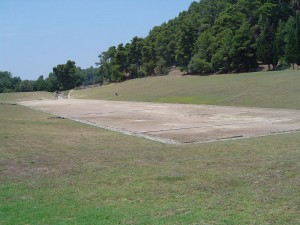Feb 10 2009
The Ancient Olympic Games
Many myths surround the origin of the ancient Olympic Games. One says that Heracles built the Olympic stadium and surrounding buildings in honor of his father Zeus, after completing his twelve labors. He would have walked 600 feet and called this distance a stadium, knowing that the demigod shod of 46 we deduce that a point is approximately 192 meters. The first Olympic Games were deemed to have taken place in 776 BC. This year marks the beginning of the Olympic calendar, that the years are grouped in Olympics. It is also the year 1 of the Greek calendar adopted in 260 BC. However, it is likely that the Games have been even earlier, given the abundance of offerings from the Geometric period found at Olympia. Therefore, Games gained importance throughout ancient Greece, but there are nearly 300 sporting events of the same type. The Olympics are with the Pythian Games, the Nemean Games and the Isthmian Games, the periodokines, the “Grand Slam” of Greek sport.

The competition schedule includes races horse (two tanks and four horses) and athletic events say gymnastics (running over several distances, discus throw, long jump, javelin throw, pentathlon [1], control, boxing and pankration). Disc length and javelin do not have Olympic title but part of the five events of the pentathlon with the stadion race and fight. Coroebos opened the official medal tally by winning the race trail Stage in 776 BC. Among the other major Greek athletes of the ancient Olympics included such Milo of Croton (wrestling, sixth century BC.) Diagoras of Rhodes (Boxing, V century BC. J.-C .) Polydamas of Skotoussa (pankration, sixth century BC.) Leonidas of Rhodes (race, second century BC.) and Melankomas of Caria (boxing, first century). From the seventh Olympiad (752 BC.) Olympic champion receives a crown of wild olive, a ribbon of red wool, the taenia, and a palm branch. The Messenian Daikles is the first Olympic champion honored as well.
Reserved initially only to Greek citizens and wealthy men, the Games generate an Olympic Truce. This does not stop the conflict, but allows athletes and spectators to move freely across war zones without being disturbed. The champions are true heroes and popular are covered with gifts and honors on their return to their city. They are becoming fully professional since the fifth century BC and may change the city they defend the colors. These transfers often cause real problems, sometimes significant, in the City “betrayed”. We can cite the case of Astylos Crotone (6 Olympic titles), which passes from Crotone to Syracuse in 484 BC.